Alternative Edible Leaves
Most of the leaf crops we grow for food are annual plants - with all the work and problems associated with the growing of annuals such as digging the soil, preparing seed beds, sowing seed, weeding, more weeding and yet more weeding. This section is going to look at a few of the many perennial leaf crops that can be grown in the garden with a fraction of the work and often with higher total yields. Whilst many perennial food crops can be slow to begin yielding, growing perennial plants for their leaves will usually give you at least a small crop in the first year and this will then increase in the following years. The variety in tastes and textures is quite staggering - especially for those people who regard a salad as consisting of the standard lettuce, spring onions, radish, cucumber and tomatoes.
By growing some of the plants described here, it would be possible to have salads including many different types of leaves, some of which will have a mild flavour and can be used in quantity to form the bulk of the salad, others will have stronger tastes and will be used more as flavourings. These stronger flavours can be very sweet, often with a liquorice-like flavour. They can be rather acid, with a lemon-like flavour. Some of them have a more savoury taste, often with a garlic or mustard flavour, whilst others are pungently hot. Not only is there this wonderful range of flavours to choose from, but leaves are also the most nutritious of all the foods we eat. Amongst their many benefits to the health, they are rich sources of vitamins and minerals, contain a very good quality protein and supply essential dietary fibre. See the section 'Green Gold - The Leaves of Life' for more details of this.
The range of plants listed below is quite diverse, and species suitable for any niche in the garden will be found. It is therefore very difficult to give general notes on their cultivation needs, though a very brief guide will be given. Fuller details on each plant can be found in the pfaf.org online database.
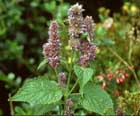 Agastache foeniculum. ANISE HYSSOP grows about 75cm tall and wide, preferring a sunny position and a dry well-drained soil. It is not hardy in the colder areas of temperate regions, tolerating winter temperatures down to between -5 and -10°c. Although easy to grow, the young growth in spring is very susceptible to slug damage and you might need to give the plant some protection at this time. The plant flowers in mid to late summer, although not very showy, these flowers are very attractive to bees and butterflies.
Agastache foeniculum. ANISE HYSSOP grows about 75cm tall and wide, preferring a sunny position and a dry well-drained soil. It is not hardy in the colder areas of temperate regions, tolerating winter temperatures down to between -5 and -10°c. Although easy to grow, the young growth in spring is very susceptible to slug damage and you might need to give the plant some protection at this time. The plant flowers in mid to late summer, although not very showy, these flowers are very attractive to bees and butterflies.
The leaves are available from mid spring until early autumn and have a sweet aniseed flavour. They make a delicious addition to the salad bowl, and can also be used to flavour cooked foods, especially acid fruits. The only drawback to the leaves is that they tend to have a drying effect in the mouth and so cannot be eaten in quantity.
 Allium species. All members of this genus, which includes the onion, leek and garlic, are edible. By careful selection, it is possible to provide fresh leaves all year round for use in salads and as flavouring in cooked dishes. The flavours range from mild onion right through to the strongest garlic. We will only give a very brief list here of some of our more favourite species, for more information please see the pfaf.org website on 'Allium species - the Perennial Onions', which deals with this genus in much greater detail. Unless stated otherwise, all members of this genus require a well-drained soil and a sunny position. In general they do not grow well with weed competition, though there are exceptions.
Allium species. All members of this genus, which includes the onion, leek and garlic, are edible. By careful selection, it is possible to provide fresh leaves all year round for use in salads and as flavouring in cooked dishes. The flavours range from mild onion right through to the strongest garlic. We will only give a very brief list here of some of our more favourite species, for more information please see the pfaf.org website on 'Allium species - the Perennial Onions', which deals with this genus in much greater detail. Unless stated otherwise, all members of this genus require a well-drained soil and a sunny position. In general they do not grow well with weed competition, though there are exceptions.
Allium cepa. This species includes the common ONION, which will not be discussed here. There is, however, a very interesting and productive form called the EVERLASTING ONION. This grows in a similar manner to chives, quickly forming a large clump. The leaves have a mild onion flavour and can be used like spring onions in salads or as a flavouring in cooked foods. The plant is evergreen and very hardy, so it can provide its edible leaves all year round, even in quite severe winters.
Allium fistulosum. The WELSH ONION is rather similar to the above species in growth habit and flavour. It is not quite so winter hardy, though, and in severe winters will die back to the ground. However, iIt will soon grow away again with the return of warmer weather in the spring.
Allium neapolitanum. DAFFODIL GARLIC grows about 30cm tall, forming a gradually expanding clump. This leaf first produces has a delicious sweetness In the mouth, followed by a moderately strong garlic flavour. A plant for a warm sunny bed, it is not very winter hardy outside the south of Britain. It comes into growth in the autumn, provides its leaves all through the winter then flowers in the spring and dies down until the following autumn.
Allium schoenoprasum. CHIVES are perhaps too well known to be included here, but it is worth reminding you that they are a very productive crop and can supply their mild, onion flavoured leaves from late winter until late autumn.
Allium triquetrum. THREE-CORNERED LEEK has become naturalised in south-western Britain where it often forms large colonies in lightly shaded places. It is an ideal plant for growing at the base of a hedge or on a woodland edge. Like the previous species, this is a plant that grows in the winter and is dormant in the summer. The leaves have an onion-garlic flavour and can be used in quantity in salads.
Like the previous species, this plant is not very cold tolerant though by giving it the protection of the trees and shrubs in the woodland it will succeed in many areas.
Allium tuberosum. GARLIC CHIVES forms a slowlyspreading clump about 30cm tall. As the common name suggests, the leaves have a very pleasant flavour very much like a cross between garlic and chives. They are available from the middle of spring until late autumn. The plant is capable of growing all year round in warmer climates and so, if you pot them up in late summer and grow them on the kitchen windowsill, you will be able to pick the leaves all through the winter.
Allium ursinum. WILD GARLIC is a native plant and is often found forming large colonies in woodlands. If it is not growing wild near you, then it is quite easy to establish the plant in a shady part of the garden. It will be more than capable of looking after itself and will provide you with its garlic flavoured leaves from late winter until late spring.
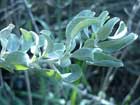 Atriplex halimus. The SALT BUSH is an evergreen shrub growing about 1.5 metres tall and wide. It requires a very sunny position in a well-drained soil and makes a good hedge. Instead of spending all your time trimming hedges, grow this plant and trim it by harvesting the young growth for use in salads and as a spinach substitute. The leaves have a distinctive salty taste and have become one of our favourites. The only problem we have with it is that it produces very little growth in the winter and so harvesting at this time of the year has to be very moderate. The plant soon bursts into vigorous growth with the warmer spring weather and can then be harvested in quantity. When picking the leaves, do not strip them from the stems but instead pick the whole stem. Harvest just the top 3 - 5cm if using them in salads, but harvest young shoots up to 25cm long if cooking them. When lightly steamed, the leaves retain their flavour and texture well, making an excellent spinach substitute.
Atriplex halimus. The SALT BUSH is an evergreen shrub growing about 1.5 metres tall and wide. It requires a very sunny position in a well-drained soil and makes a good hedge. Instead of spending all your time trimming hedges, grow this plant and trim it by harvesting the young growth for use in salads and as a spinach substitute. The leaves have a distinctive salty taste and have become one of our favourites. The only problem we have with it is that it produces very little growth in the winter and so harvesting at this time of the year has to be very moderate. The plant soon bursts into vigorous growth with the warmer spring weather and can then be harvested in quantity. When picking the leaves, do not strip them from the stems but instead pick the whole stem. Harvest just the top 3 - 5cm if using them in salads, but harvest young shoots up to 25cm long if cooking them. When lightly steamed, the leaves retain their flavour and texture well, making an excellent spinach substitute.
The plant is very wind resistant and is tolerant of very salty soils and also of dry conditions. It makes an excellent shelter hedge in maritime areas. It is not cold-hardy in all areas, being defoliated if temperatures drop much below -5°c for any period of time, and often being killed at temperatures much below -10°c.
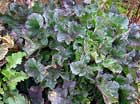 Brassica oleracea. This species includes some of our most common vegetables such as the cabbage, cauliflower and Brussels sprouts. Whilst these plants are biennial, there are also a few perennial forms. Although not widely known, these perennials can be amongst the most productive food plants that can be grown in the garden. They all grow best in a sunny position and succeed in most soils, doing well in heavy clays. They do not like very acid conditions.
Brassica oleracea. This species includes some of our most common vegetables such as the cabbage, cauliflower and Brussels sprouts. Whilst these plants are biennial, there are also a few perennial forms. Although not widely known, these perennials can be amongst the most productive food plants that can be grown in the garden. They all grow best in a sunny position and succeed in most soils, doing well in heavy clays. They do not like very acid conditions.
The true wild form of B. oleracea is the WILD CABBAGE, which can still be found growing by the sea in many parts of the country. A short-lived evergreen perennial, it can grow up to 1.2 metres tall. The leaves have a stronger flavour than the cultivated cabbages, and at times can have a distinct bitterness, especially in the winter. However, you may find this to be a very acceptable cooked vegetable. Plants will usually live for 3 - 5 years, though some can reach 10 years old or more.
Whilst most of the plants developed from the wild cabbage have lost the ability to be perennial, there are just a few forms where the perennial tendency has been increased. One worth considering is the TREE COLLARDS. This plant grows about 2 metres tall and wide, living for up to 20 years. It has mild flavoured dark green leaves that are wrinkled and look rather like Savoy cabbage leaves, though the plant does not form a heart. You harvest the young shoots when 5 - 25cm long and cook them stem and all. They are an excellent cabbage substitute.
A variety of KALE called ‘Daubenton’ is another very good perennial form. About the same size as the preceding species, the leaves have a somewhat coarser flavour but make a very acceptable cooked vegetable.
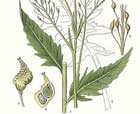 Bunias orientalis. TURKISH ROCKET grows into a clump about 75cm tall and wide. It is a very easily grown plant, succeeding in most soils and preferring a sunny position, though It can also succeed in the light shade of a woodland garden. The plants are also tolerant of considerable neglect and, once established, will grow quite well even in long grass.
Bunias orientalis. TURKISH ROCKET grows into a clump about 75cm tall and wide. It is a very easily grown plant, succeeding in most soils and preferring a sunny position, though It can also succeed in the light shade of a woodland garden. The plants are also tolerant of considerable neglect and, once established, will grow quite well even in long grass.
The young leaves have a mild flavour that is a cross between cabbage and radish. They go very well in a mixed salad and when cooked make an excellent vegetable. They are available early in the year, usually towards the end of winter, and the plant will continue to produce leaves until late autumn, with a bit of a gap when the plant is in flower.
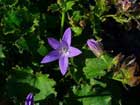 Campanula species. This is a very large genus that contains some very desirable ornamental plants. They are in general fairly easy to grow, most of them preferring a position in full sun and all of them requiring a well-drained soil. They are little bothered by pests and diseases, though slugs adore the leaves and can totally decimate the plants in wet weather.
Campanula species. This is a very large genus that contains some very desirable ornamental plants. They are in general fairly easy to grow, most of them preferring a position in full sun and all of them requiring a well-drained soil. They are little bothered by pests and diseases, though slugs adore the leaves and can totally decimate the plants in wet weather.
All members of this genus have more or less edible leaves, and some of them have such nice tasting leaves that It is surprising they are not better known. Only a few favourites are mentioned here, though feel free to try any other species you might be growing since none of them are poisonous.
C. persicifolia. This species grows about 1 metre tall, spreading quite quickly at the roots to form large clumps. It does well in light shade as well as full sun, growing well on a woodland edge. The leaves are rather narrow but have a pleasant slightly sweet flavour that can be used in salads. In mild winters, or when given the protection of a woodland, the plants will often produce leaves in the winter and can therefore be harvested all year round. The sub-species C. persicifolia crystalocalyx has larger leaves than the species and so is more suitable as a food crop.
C. poscharskyana. This is a low-growing evergreen plant. About 20cm tall, it spreads rapidly at the roots to form large clumps and therefore makes an excellent ground cover in a sunny position or light shade. Very tolerant of dry conditions, it will even succeed on an old brick wall. The leaves have a slightly sweet flavour, but are a bit on the chewy side. They provide a good source of winter leaves. and are an acceptable addition to mixed salads.
C. portenschlagiana is rather similar to the above and can be used in the same ways.
C. takesimana. Growing about 50cm tall and spreading rapidly at the roots, the leaves and leaf stems of this plant have a very similar flavour to iceberg lettuce. They are available from early spring until the autumn, though they can become a bit bitter in the summer.
C. versicolor. Growing up to 1.2 metres tall, this is an excellent salad plant. The leaves have a delicious sweetness that is very similar to fresh garden peas. The plants have a tap root and do not spread. They form a basal rosette of leaves in the winter and can be harvested in moderation in mild winters, and then in greater quantities in the spring and summer. Unfortunately, the plant is only hardy in milder areas and is not very productive of leaves. It is also very susceptible to attacks by slugs. However, if you want to give it a bit of extra care, it will reward you with some very tasty salads and also a superb display of flowers from mid summer until well into the autumn.
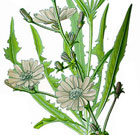 Cichorium intybus. CHICORY forms a rosette of leaves up to 50cm tall, though when flowering it sends up a shoot that can be 1.5 metres tall. It prefers growing in a sunny position and will succeed in any moderately fertile well-drained moisture retentive soil, though it is most at home in chalky soils.
Cichorium intybus. CHICORY forms a rosette of leaves up to 50cm tall, though when flowering it sends up a shoot that can be 1.5 metres tall. It prefers growing in a sunny position and will succeed in any moderately fertile well-drained moisture retentive soil, though it is most at home in chalky soils.
Chicory leaves are quite bitter, and few people can eat them in quantity. However, they are very nutritious and are especially beneficial to the healthy functioning of the liver and kidneys. Perhaps the best way of eating them is to chop them quite finely and use them as a minor ingredient of mixed salads that also contain some of the sweeter tasting leaves - this way you get their health benefits without really noticing the bitterness. Chicory is one of the most productive and reliable winter salad crops, though unfortunately you have to sow the seed of selected cultivars each year in order to produce winter leaves - see the section 'Winter Salads' for more information on this.
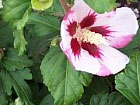 Hibiscus syriacus. The ROSE OF SHARON is a deciduous shrub that grows up to 3 metres tall and 2 metres wide, though it can be kept smaller by trimming it, and can be grown as a hedge. It prefers a well-drained humus rich fertile soil in a sheltered position in full sun and succeeds in any soil of good or moderate quality. Plants are hardy to about -20°c but plants only really succeed in the warmer areas because of their late flowering habit. They are also slightly tender when young and when planted in colder areas, they will need protection for the first few winters.
Hibiscus syriacus. The ROSE OF SHARON is a deciduous shrub that grows up to 3 metres tall and 2 metres wide, though it can be kept smaller by trimming it, and can be grown as a hedge. It prefers a well-drained humus rich fertile soil in a sheltered position in full sun and succeeds in any soil of good or moderate quality. Plants are hardy to about -20°c but plants only really succeed in the warmer areas because of their late flowering habit. They are also slightly tender when young and when planted in colder areas, they will need protection for the first few winters.
The young leaves can be eaten raw or cooked. They have a very mild, slightly nutty flavour, and though slightly on the tough side they make an acceptable addition to the salad bowl.
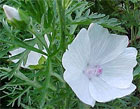 Malva moschata. The MUSK MALLOW is a very easily grown plant that succeeds in most soils, though it prefers a reasonably well-drained and moderately fertile soil in a sunny position.
Malva moschata. The MUSK MALLOW is a very easily grown plant that succeeds in most soils, though it prefers a reasonably well-drained and moderately fertile soil in a sunny position.
The leaves are available from early or mid spring until the plant comes into flower in the summer. If the plants are then trimmed back, they will produce a fresh flush of leaves in late summer and the early autumn. The leaves have a pleasant mild flavour with a mucilaginous texture that is very beneficial to the digestive system. These leaves can be used in bulk in salads, and they make an excellent lettuce substitute. M. alcea is a closely related species that can be used similarly.
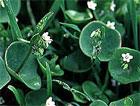 Montia perfoliata (Claytonia perfoliata) . MINER’S LETTUCE is a short-lived annual to perennial plant, but it self-sows so freely that you will never be without it. Growing about 15cm tall, it usually forms a carpet of growth and makes a good ground cover. It prefers a moist peaty soil, though it can succeed on very poor and dry soils and thrives in the shade of trees. The leaves have a fairly bland flavour with a mucilaginous texture; they make a very acceptable salad and are available all year round, even in severe winters.
Montia perfoliata (Claytonia perfoliata) . MINER’S LETTUCE is a short-lived annual to perennial plant, but it self-sows so freely that you will never be without it. Growing about 15cm tall, it usually forms a carpet of growth and makes a good ground cover. It prefers a moist peaty soil, though it can succeed on very poor and dry soils and thrives in the shade of trees. The leaves have a fairly bland flavour with a mucilaginous texture; they make a very acceptable salad and are available all year round, even in severe winters.
M. sibirica is a closely related species. It is more reliably perennial and can even succeed in the dense shade of beech trees. The leaves have a stronger flavour, with a distinct earthy taste of raw beetroot that not everyone likes.
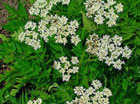 Myrrhis odorata. SWEET CICELY grows up to 1 metre tall and wide. It prefers a moist rich soil in a shady position and grows very well on a woodland edge. The leaves have a delicious sweet aniseed flavour and make an excellent addition to mixed salads. They are also used as a flavouring for vegetables and can be cooked with tart fruits in order to reduce their acidity. The plant produces fresh leaves from late winter until early the following winter.
Myrrhis odorata. SWEET CICELY grows up to 1 metre tall and wide. It prefers a moist rich soil in a shady position and grows very well on a woodland edge. The leaves have a delicious sweet aniseed flavour and make an excellent addition to mixed salads. They are also used as a flavouring for vegetables and can be cooked with tart fruits in order to reduce their acidity. The plant produces fresh leaves from late winter until early the following winter.
 Oxalis deppei. The IRON CROSS PLANT is a very attractive bulbous plant that forms a fountain of leaves and flowers about 25cm tall and 15cm wide. Easily grown, it prefers a sandy soil in a warm dry sunny position and dislikes dry or heavy soils. It is only hardy outdoors in the milder temperate areas, tolerating temperatures down to about -5°c or perhaps a bit lower if the soil is very well-drained. The bulbs are easily harvested in late autumn, however, and can be stored overwinter in a cool frost free place, replanting them in the spring. In milder winter areas a good mulch is usually sufficient to see the bulbs through the winter and they will then normally be more productive of leaves and flowers in the following year.
Oxalis deppei. The IRON CROSS PLANT is a very attractive bulbous plant that forms a fountain of leaves and flowers about 25cm tall and 15cm wide. Easily grown, it prefers a sandy soil in a warm dry sunny position and dislikes dry or heavy soils. It is only hardy outdoors in the milder temperate areas, tolerating temperatures down to about -5°c or perhaps a bit lower if the soil is very well-drained. The bulbs are easily harvested in late autumn, however, and can be stored overwinter in a cool frost free place, replanting them in the spring. In milder winter areas a good mulch is usually sufficient to see the bulbs through the winter and they will then normally be more productive of leaves and flowers in the following year.
The leaves are available from late spring until the autumn frosts. They have a delicious lemony flavour and make an excellent flavouring in salads
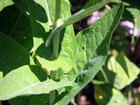 Peltaria alliacea. GARLIC CRESS is a vigorous spreading plant that grows up to 30cm tall and makes a good ground cover in a sunny position or in light shade. It prefers a light fertile moist soil though it is not too fussy.
Peltaria alliacea. GARLIC CRESS is a vigorous spreading plant that grows up to 30cm tall and makes a good ground cover in a sunny position or in light shade. It prefers a light fertile moist soil though it is not too fussy.
An evergreen plant, it provides its edible leaves all year round apart for a few weeks in the summer when it is flowering and producing seed. These leaves have a strong garlic/mustard flavour which we find makes an excellent addition to salads or cooked dishes. They do develop a rather bitter aftertaste in hot dry weather, though.
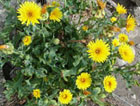 Reichardia picroides. Looking somewhat like a dandelion, this plant grows about 30cm tall and wide, forming a basal rosette of leaves. It is easily grown in any moderately fertile well-drained soil in a sunny position, though it grows best in a shady position in summer where it will produce better quality leaves. It is not hardy in the colder areas of the country, tolerating temperatures down to between -5 and -10°c. It is likely to be hardier when grown in a soil on the poor side, though the leaves will not be so tender nor so freely produced. Plants are also likely to be hardier in well-drained soils and they dislike very wet weather. Ken Fern found this plant to be almost totally slug-proof, even in a very heavily slug-infested garden.
Reichardia picroides. Looking somewhat like a dandelion, this plant grows about 30cm tall and wide, forming a basal rosette of leaves. It is easily grown in any moderately fertile well-drained soil in a sunny position, though it grows best in a shady position in summer where it will produce better quality leaves. It is not hardy in the colder areas of the country, tolerating temperatures down to between -5 and -10°c. It is likely to be hardier when grown in a soil on the poor side, though the leaves will not be so tender nor so freely produced. Plants are also likely to be hardier in well-drained soils and they dislike very wet weather. Ken Fern found this plant to be almost totally slug-proof, even in a very heavily slug-infested garden.
The leaves have a pleasant agreeable flavour with a slight sweetness; they make a very acceptable lettuce substitute. Unlike most salad plants, the older leaves often have a sweeter and more pleasant flavour than the young ones and remain sweet even when the plant is in flower. Cut the plant back regularly in the summer in order to produce fresh crops of leaves and make harvesting easier. In areas with mild winters the plant will provide edible leaves all year round.
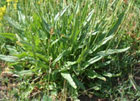 Rumex acetosa. SORREL is a very easily grown and tolerant plant that can be up to 50cm tall and 30cm wide. It succeeds in most soils though it prefers a moist moderately fertile well-drained soil in a sunny position. Established plants are tolerant of considerable neglect, surviving and producing tasty leaves even in dense weed growth. They will also grow well in the sunnier areas of a woodland garden.
Rumex acetosa. SORREL is a very easily grown and tolerant plant that can be up to 50cm tall and 30cm wide. It succeeds in most soils though it prefers a moist moderately fertile well-drained soil in a sunny position. Established plants are tolerant of considerable neglect, surviving and producing tasty leaves even in dense weed growth. They will also grow well in the sunnier areas of a woodland garden.
The leaves have a delicious acid flavour, they make a marvellous flavouring in mixed salads and can also be cooked like spinach. They can be munched on when working in the garden, as they have a very refreshing effect on the mouth and also relieve thirst. There are some named varieties of this species that have been selected for their larger leaves and reluctance to flower. For example, Ken Fern grew a Polish form that only flowered once in seven years, and produced masses of large leaves, with a small crop of smaller leaves all through the winter.
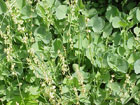 Rumex scutatus. FRENCH SORREL has a similar taste to the above, though is perhaps more delicate. Another very productive plant, though the leaves are rather smaller. It is a very drought tolerant plant and can even be grown in old walls.
Rumex scutatus. FRENCH SORREL has a similar taste to the above, though is perhaps more delicate. Another very productive plant, though the leaves are rather smaller. It is a very drought tolerant plant and can even be grown in old walls.
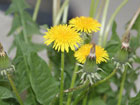 Taraxacum officinale. The DANDELION is a common weed of lawns, growing about 30cm tall and producing a mass of attractive flowers in the spring. A very easily grown plant, it succeeds in most soils, though it prefers a well-drained humus-rich neutral to alkaline soil in full sun or light shade.
Taraxacum officinale. The DANDELION is a common weed of lawns, growing about 30cm tall and producing a mass of attractive flowers in the spring. A very easily grown plant, it succeeds in most soils, though it prefers a well-drained humus-rich neutral to alkaline soil in full sun or light shade.
Like the chicory mentioned earlier, dandelion leaves are rather bitter but are an extremely healthy addition to the diet. If chopped and added in small quantities to mixed salads their bitterness is not overpowering. The easiest way of growing dandelions is to just allow them to look after themselves in the lawn. Not only will they provide you with edible leaves all year round, but they will also make the lawn look really pretty when they are flowering in the spring. There are also some cultivated forms of dandelion that are supposed to have better tasting leaves, though this is a matter of opinion.
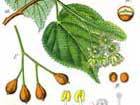 Tilia cordata. The LIME TREE prefers a good moist loamy alkaline to neutral soil but it also succeeds on slightly acid soils. Growth is rather poor, however, if the soil is very dry or very wet. The plant tolerates considerable exposure to the wind and succeeds in sun or semi-shade.
Tilia cordata. The LIME TREE prefers a good moist loamy alkaline to neutral soil but it also succeeds on slightly acid soils. Growth is rather poor, however, if the soil is very dry or very wet. The plant tolerates considerable exposure to the wind and succeeds in sun or semi-shade.
The young leaves have a mild, slightly sweet taste with a somewhat mucilaginous texture. They make an excellent salad or sandwich filling and can be used in quantity when available. Lime trees usually produce a mass of young shoots from the base of their trunks and it is often possible to harvest these leaves from the middle of spring until early autumn.
One problem with growing this tree is that the leaves are very attractive to leaf aphis. These aphis produce an abundance of sweet secretions which drip off the leaves to the ground below and also attract sooty mould fungus. Any plants growing below a lime tree are likely to become covered with this mould.
All the other members of this genus also produce edible leaves -though some are rather on the tough side. We would most recommend our other two native species, T. platyphyllos and T. x vulgaris.
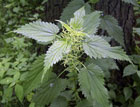 Urtica dioica. STINGING NETTLES are an excellent and nutritious cooked vegetable. They can usually be found growing luxuriantly in the wild, so there is little or no need to cultivate them. If you do want to grow them - and they are excellent plants for the wildlife garden as well as having a whole catalogue of other uses - then they prefer a soil rich in phosphates and nitrogen.
Urtica dioica. STINGING NETTLES are an excellent and nutritious cooked vegetable. They can usually be found growing luxuriantly in the wild, so there is little or no need to cultivate them. If you do want to grow them - and they are excellent plants for the wildlife garden as well as having a whole catalogue of other uses - then they prefer a soil rich in phosphates and nitrogen.
The young leaves make a very good spinach substitute and are also used for making soups. But they do smell rather like fish when they are cooking, which some may find unpleasant. Nettles are a very nutritious food that is easily digested and is high in minerals (especially iron) and vitamins (especially A and C). Only use the young leaves since old leaves can cause kidney upsets, and always wear stout gloves when harvesting them to prevent being stung. Cooking the leaves, or thoroughly drying them, completely neutralises the sting, rendering the leaf safe to eat.
Database
The database has more details on these plants: Agastache foeniculum, Allium cepa, Allium fistulosum, Allium neapolitanum, Allium schoenoprasum, Allium triquetrum, Allium tuberosum, Allium ursinum, Atriplex halimus, Brassica oleracea, Bunias orientalis, Cichorium intybus, Hibiscus syriacus, Malva moschata, Myrrhis odorata, Oxalis deppei, Peltaria alliacea, Reichardia picroides, Rumex acetosa, Rumex scutatus, Taraxacum officinale, Tilia cordata, Urtica dioica.